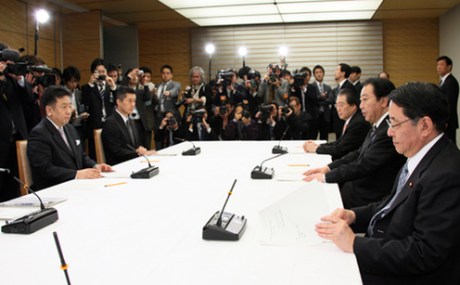 |
| Key ministers meet on 6 April, led by prime minister Yoshihiko Noda (third from right) |
Members of the Japanese cabinet have met publicly to discuss restarting reactors while the country's crisis of confidence in nuclear safety continues. At the centre of debate is the potential restart of two reactors at Kansai Electric Power Company's (Kepco's) Ohi plant.
Prime minister Yoshihiko Noda sat down with trade and industry minister Yukio Edano and two other cabinet colleagues on 6 April for their third discussion of the situation. They voiced general approval for the stress tests results for Ohi 3 and 4, but stopped short of signing this off and actually supporting the restart. The ministers said that Kepco needs to clarify further why the longer-term measures it is taking to secure safety against external threats need not be completed before restart. The company has outlined a four-year process to complete all the improvements.
Under the first stage of stress tests utilities are required to examine the safety margin of important pieces of equipment in accordance with guidelines to be set by the country's Nuclear and Industrial Safety Agency (NISA) and Nuclear Safety Commission (NSC). Analyses for this at Ohi 3 and 4 were presented to NISA in October and November last year respectively. A review by NISA was completed by mid-February this year, and this was confirmed by the NSC last month. It now rests with ministers to approve the completion of this first stage of the stress test process. Local approval may not be a mandatory next step, but it is the major sticking point nonetheless.
_460x306.jpg) |
| Ohi 3 and 4 during winter. Are they needed to avoid power shortages in the summer? |
Kepco's distribution region is one of Japan's most dense in terms of industry and population. It includes the Keihanshin metropolitan area spanning the cities of Osaka, Kobe and Kyoto and counting over 18 million people. Also in the region are world-class manufacturing centres belonging to firms such as Honda, Panasonic, Mitsubishi, Sharp, Kawasaki, Fujitsu, Toshiba and NEC. Power has traditionally been nuclear-rich, using uranium as the fuel for up to half of electricity, but at present all of Kepco's 11 reactor units are offline at the Ohi, Mihama and Takahama power plants. In the entire country, only one reactor is working: Tomari 3 on the northern island of Hokkaido.
Some local government figures, including the mayors of nearby towns, have been vocal critics of Kepco and the government's efforts to move forward in nuclear restarts. Some demand that the second stage of stress tests is also completed before restart, others question calculations that the Kansai region actually faces a 20% power shortfall in coming months. There is also great interest in the federal government's new emergency plan, which should address the many shortfalls in the coordination of response by points during the Fukushima accident that central government failed to act in conjunction with its various supporting agencies - as well as with Tokyo Electric Power Company as it worked to stabilise the Fukushima Daiichi plant.
Meanwhile, Japanese nuclear regulation is in transition from NISA's critcised arrangement within the Ministry of Economy, Trade and Industry to placement in a more independent body called the Nuclear Regulatory Authority (NRA) that will be linked to the Ministry of Environment. The NRA will have its own independent staff of 500 and a budget of ¥50 billion (about $600 million). Also coming under the remit of the Ministry of the Environment will be the Nuclear Safety Investigation Committee, which will review the effectiveness of the NRA and be responsible for the investigation of nuclear accidents.
Researched and written
by World Nuclear News




_47120.jpg)

_23621.jpg)






